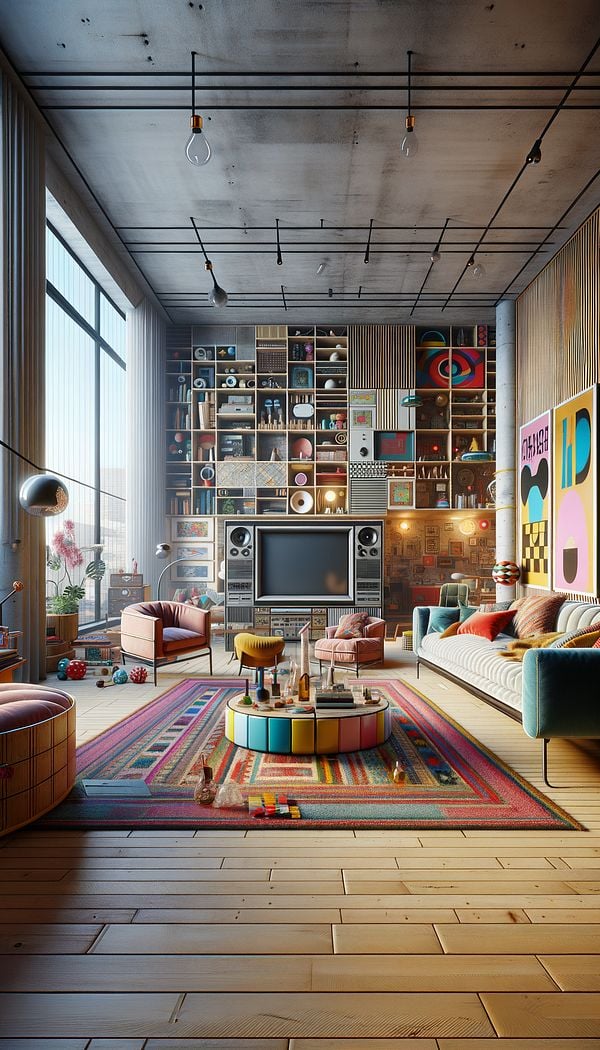What is Post-Modernism?
Post-Modernism is a diverse style and concept in interior design that emerged as a reaction to the strict rules of modernism, focusing on freedom of expression, eclectic influences, and a blend of historical and contemporary elements.
Description
Post-Modernism in interior design can be characterized by its departure from the minimalist ethos of Modernism. It emerged in the late 20th century as a critique and response to the rigid structures and ideologies of its predecessor, advocating for a more playful, eclectic, and expressive approach to design. This style embraces a mix of traditional and contemporary elements, often highlighting contrast and diversity in design choices.
Designers adopting a Post-Modern approach often experiment with unconventional materials, bold colors, and exaggerated forms to create spaces that are both functional and whimsical. The style is known for its ironic use of historical references, blending them with modern techniques and technologies. This juxtaposition of the old and new, the serious and the playful, is a hallmark of Post-Modern interior design.
Post-Modernism also reflects a broader philosophical movement that questions the universal validity of truth and emphasizes the relativity of perspective. In interior design, this translates to designs that are subjective, open to interpretation, and tailored to the individual's expression rather than conforming to a universal ideal. This approach has led to some of the most innovative and visually captivating spaces, pushing the boundaries of what is considered conventional in interior design.
Moreover, Post-Modernism encompasses a wide range of influences, from Art Deco and Neoclassicism to Pop Art, showing its capacity to adapt and merge different aesthetic trends. This eclectic mix not only challenges traditional design norms but also offers limitless possibilities for personalization and creativity in interior spaces.
Usage
Post-Modernism is frequently used in residential and commercial interiors seeking to make a bold statement or express a unique identity. Examples include living rooms with a mix of vintage and contemporary furniture, office spaces with unconventional architecture and vibrant colors, and restaurants that blend industrial and traditional design elements to create an engaging and dynamic atmosphere.
FAQs
-
How does Post-Modernism differ from Modernism in interior design?
Post-Modernism differs from Modernism by rejecting the latter's emphasis on simplicity, function, and order. Instead, it embraces eclecticism, expressive use of color and form, and the integration of historical elements with contemporary design, leading to more playful and diverse spaces.
-
Can Post-Modern design be minimalist?
While Post-Modernism typically leans towards expressive and eclectic designs, it can incorporate minimalist elements as part of its diverse aesthetic. The style celebrates freedom in design, allowing for the integration of minimalist features within a broader, more expressive context.
-
Is Post-Modernism still relevant today?
Yes, Post-Modernism remains relevant, as it offers a flexible framework that encourages individual expression and innovation. Its principles continue to influence contemporary design, particularly in projects that seek to break from convention and explore new aesthetic territories.
Practical Application
When applying Post-Modernism, consider blending different eras and styles to create a space that is uniquely yours. Look for opportunities to mix traditional elements with contemporary design, play with unconventional materials, and use color boldly. Emphasize the contrast and diversity in your choices to capture the essence of Post-Modernism in your interior spaces.
-
Design Styles478 articles
-
Decorative Objects240 articles
-
Color & Patterns154 articles
-
Textiles & Upholstery252 articles
-
Wall Treatments & Finishes157 articles
-
Drop FrontA drop front refers to a hinged panel on a piece of furniture that can be lowered to provide a horizontal surface.
-
BarkclothBarkcloth is a versatile textile made from the inner bark of certain trees.
-
Grandfather ClockA Grandfather Clock is a tall, freestanding, weight-driven pendulum clock with a long case.
-
Flemish ScrollA decorative motif featuring a symmetrical scroll with curves that meet in the middle.
-
QuiltA quilt is a multi-layered textile comprised of a woven cloth top, a layer of batting or wadding, and a woven back, combined using the technique of quilting.
